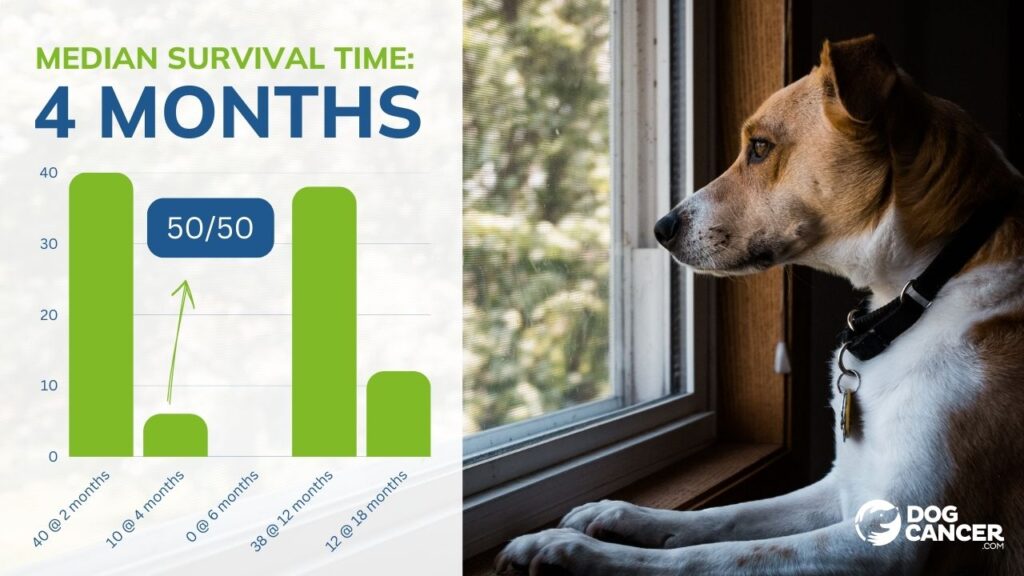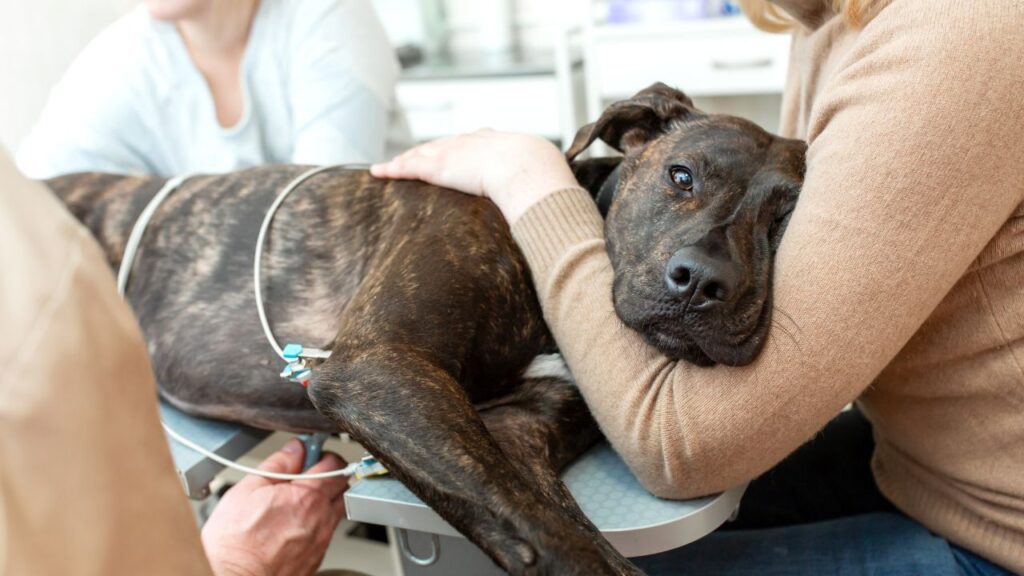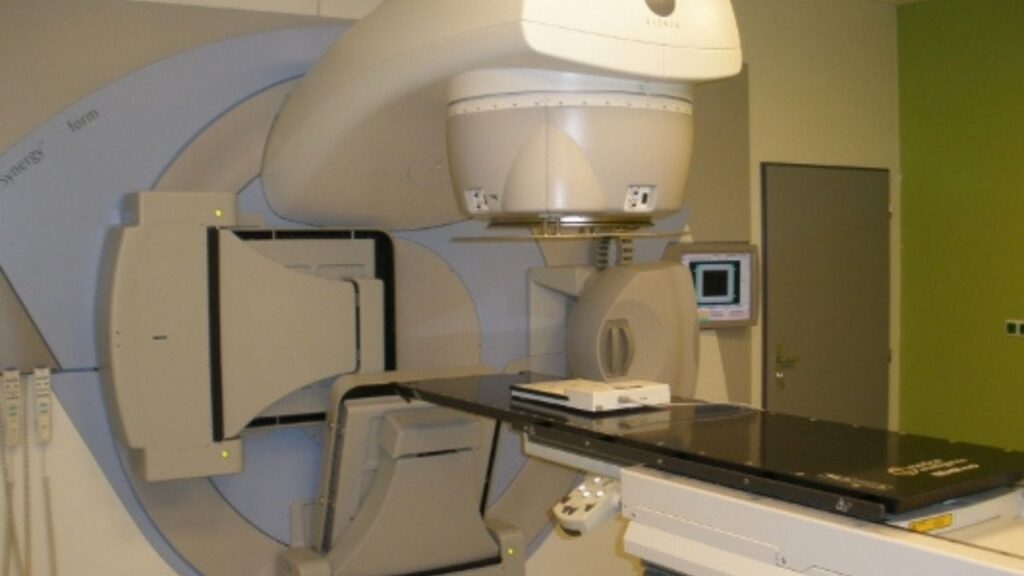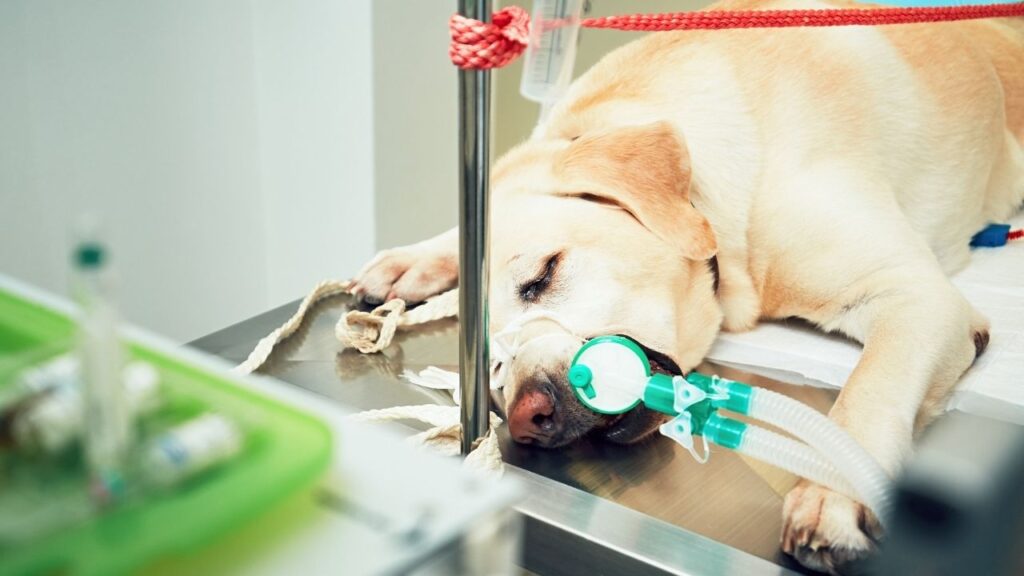Staging and grading cancer in dogs takes some time but is very helpful. It tells us how far cancer has spread and how aggressively it is likely to behave. This helps determine a dog’s prognosis and treatment plan.
Key Takeaways
- Staging refers to how large a tumor is and how far it has spread from its original location. The higher the stage, the more a cancer has spread to other places in the body.
- Grade describes the behavior of a cancer and how aggressive it is. How aggressive a cancer is can give insight into how likely it is to spread.
- Stage 5 cancer in a dog typically is used in lymphoma staging and is the last stage. It indicates that the bone marrow or other organ system is impacted. This is the final stage of the disease.
- Stage 4 cancer in dogs can refer to multiple different cancers. For lymphoma, it relates to the second to last stage and indicates that the liver and/or spleen are involved. For mast cell tumors, Stage 4 is the last stage and indicates distant metastasis.
- Tumor grading in dogs requires microscopic evaluation of the cancer cells and is most accurately done on larger samples of tumor tissue like whole tumors or biopsies.
Staging and Grading: Important for Understanding and Planning
Unfortunately, knowing your dog has cancer isn’t usually enough to make a treatment plan. Staging and grading cancer in dogs is the next step.
Once you gain the information from staging and grading tests, your veterinarian or veterinary oncologist can offer you treatment options.
Let’s go over some terms to begin our discussion.
- Your dog’s cancer stage tells us how much the cancer has already progressed. The higher the stage number, the more advanced the cancer is.
- Your dog’s cancer grade tells us how aggressive this cancer is.
- Your veterinarian will arrive at a prognosis based on the stage, grade, and multiple other factors, depending upon your dog’s case. The prognosis will describe the most likely course of the disease. It may also include an estimate of your dog’s lifespan and quality of life issues. The word prognosis means “educated guess” and should not be taken as a prediction. It often is given in terms of median survival times, which is a type of statistic and doesn’t apply to any one dog.
Let’s look closer at staging dog cancer.
Dog Cancer Staging
Cancer staging is a way of determining the extent to which cancer has progressed. The higher the stage number, the more progressed the cancer is, and often, the worse the prognosis is as well.
As you’ll see below, different cancers have different staging systems. What stage your dog’s cancer is in will be based on how large the original tumor is and/or whether there is metastasis, and sometimes, where the metastasis has occurred.
Knowing where the cancer is and how much is there gives the information used to estimate prognosis, lifespan, and quality of life.
This information also helps your veterinarian know what treatments will be best for your dog.
Different Staging Systems for Different Cancer Types
The staging process differs depending on the cancer type.
- Systemic cancers that affect the blood or bone marrow, such as lymphoma, can have different staging systems than single tumors or individual masses.
- Other blood cancers, such as leukemia, may not have a specific staging system.
- Brain and spinal cord cancers also have specific staging systems determined by their cell type and grade of cancer.1
Let’s look more closely at the types of tests used to stage cancer in dogs.
Veterinary oncologist Dr. Brooke Britton explains staging and grading on DOG CANCER ANSWERS.
How Veterinarians Determine the Stage of Dog Cancer
There are many tests used in the staging process. These tests include:
- Physical exam
- Blood work
- X-rays
- Ultrasound
- CT scans
- MRI
- Biopsy of tissue areas near the original cancer site
These tests help your veterinarian determine the extent of the original tumor, which lymph nodes it has spread to, and the extent of spread to distant tissues or organs.
Let’s look at each of these more closely.
Physical Examination
The physical exam is the first critical element of staging. Your veterinarian will:
- Measure the tumor if it is external and visible
- Feel lymph nodes to determine their size and possible involvement
- Examine and feel the abdomen for any related abnormalities
- Listen to the heart and lungs to check for anything unusual
Imaging
While the physical exam can evaluate some elements of internal structure through feel and sound, imaging is an essential component of staging cancer.
Imaging methods make it possible to look inside the body for evidence of cancer. With this technology, specific types of pictures or videos can be taken to help your veterinarian visualize the inside of the body.
Imaging methods from most common to least common include:
- X-ray
- Ultrasound
- CT scan
- MRI
- PET scans
These methods help the vet determine where the cancer is and how much of it there is.
Biopsies and Pathology Reports
Pathology reports are written descriptions of samples of cancer. They can tell us the size of a tumor, the cancer cell type, and how aggressive it is. To get a pathology report, a biopsy is needed. A biopsy is a small surgery that takes a sample of your dog’s tumor.
Next, a pathologist, a specialist, uses a microscope to look at cell details of a sample of your dog’s tumor. The pathologist records everything they see and writes it up in a pathology report for you and your veterinarian(s).
These reports may be made after the pathologist evaluates a piece of affected tissue (biopsy), a whole tumor after removal, or a small sample of cells on a slide (cytology).
Surgical reports and pathology reports performed after the removal of affected tissue can also provide information on the tumor size, appearance, lymph node involvement, and if the whole tumor was removed or some cells were left behind.
Dr. Demian Dressler and veterinary oncologist Dr. Susan Ettinger (Dr. Sue Cancer Vet) explain fine needle aspirates and biopsy.
Bloodwork and Other Testing
Laboratory reports such as blood work, urinalysis, and specific tissue testing can be helpful.
- Blood tests and urinalysis give a good overview of your dog’s health.
- Values relating to the kidneys, liver, and some parts of the gastrointestinal tract can sometimes give information about whether or not that tissue is affected by cancer.
Some tests can be done on organ tissue or fluid that use advanced lab methods to genetically identify specific cancer cell types. There aren’t tests for every cancer yet, but this is an area of growth in research.
What the Cancer Stage Means
There are multiple specific systems to describe how large a cancerous tumor is and how far it has spread. In general, if a staging system uses numbers, higher numbers mean more advanced cancer.
One of the most widely used systems of staging is abbreviated TNM.2
- The “T” refers to the primary tumor type, size, and extent.
- The “N” refers to lymph nodes. This describes how many are involved and to what extent.
- The “M” refers to the presence of distant metastasis.
This system will have additional letters or numbers following the T, M, or N. These give more specific information about the extent of the cancer.2
Your veterinarian will let you know how your dog’s specific cancer is staged. For the purpose of explanation, let’s briefly look at two common cancers and how they are staged.
Lymphoma Staging
Since lymphoma is a cancer of white blood cells and does not start as a physical tumor, the TNM system doesn’t work. Instead, lymphoma has its own staging method. Lymphoma (Lymphosarcoma, LSA) has five main stages depending on extent of disease in the body:3
- Stages I-V are based on how many lymph nodes are enlarged and whether or not they include both halves of the body (front and back).
- Stage IV indicates that the liver and/or spleen are involved.
- Stage V indicates that the bone marrow or another organ system is impacted.
- Each stage can have a substage A, which indicates the patient feels well, or a substage B, which indicates that the patient feels ill.
Mast Cell Tumor Staging
Mast cell tumors also have a staging system that is made up of stages 0-4. This system is based on:
- How many tumors are present
- Whether or not there was complete surgical removal
- How many lymph nodes (if any) are involved
- If there is distant metastasis (Stage 4)
- Within Stage 4, there are substages A and B that refer to the presence or absence of signs such as vomiting and diarrhea
Dog Cancer Grading
While stage refers to the extent or spread of cancer, grade refers to the qualities of the tumor itself and how likely it is to spread based on this.
The grade is a way of predicting the biological behavior of the cancer.
For example, a higher-grade tumor indicates a more aggressive cancer. As a result of this, the oncologist may recommend a more aggressive treatment plan that involves multiple modes or angles of treatment.
These grades help decide the overall prognosis and progression of the disease to determine the best planning for treatment and guardian expectations.
How Veterinarians Determine Dog Cancer Grade
Grading requires an evaluation of the cancer cells under a microscope. More extensive biopsies or a whole tumor are usually the best option for accuracy. These large samples are cut into thin, small pieces to be evaluated.
How the cells look will determine the grade of a tumor. The pathologist will look at how similar the cells look to each other, how similar the nuclei (center) of the cells look to each other, how fast the cells appear to be dividing, and how similar the cancer cells look to a normal cell.
Some pathology reports automatically include a grade, but at other times, your veterinarian will need to request it specifically.
What the Cancer Grade Means
Low-grade tumors generally have a better prognosis. They have a lower risk of regrowing after removal, a lower risk of invading surrounding tissue, and a lower risk of spreading to distant places in the body.
Any tumor designated as high-grade typically has a worse prognosis. They tend to have shorter survival times and a higher likelihood of spreading.
Different tumor types might have very specific grading systems.
- Mast cell tumors are frequently divided into high-grade and low-grade as a two-tier system.
- Soft tissue sarcomas have a more complex system, as do many carcinomas.
- Some people also divide lymphoma into high-grade or low-grade depending on the cell size and type of lymphocyte affected.
When Grade Doesn’t Matter
There are some cancers for which we do not have a sound grading system. For these cancers, the cell characteristics measured do not tell us much about the cancer’s behavior within the body. In that scenario, the grade is not considered useful.
An example of this is squamous cell carcinoma of the digits (toes).4 If your dog has this cancer or another that doesn’t have a validated grading system, your veterinarian will not bother requesting a grade.
Costs Associated with Staging and Grading Cancer in Dogs
The cost of staging and grading varies depending on tumor type and where you live.
Some (very) general estimates for diagnostics are:
- X-rays: $100-700 depending on how many images are taken and if a boarded radiologist is viewing them. A standard 3-view x-ray study with a review by a boarded radiologist is about $350.
- Physical exam: An exam by a general practice veterinarian ranges from about $50-100. An exam by an oncologist or other specialist ranges between about $150-$250.
- Ultrasound: $300-500 depending on what part of the body is examined and whether a specialist performs it or not.
- CT: Usually around $1500-2000.
- MRI: Around $3000-5000.
- Pathology reports/histopathology: The review of the sample is about $250-350 for a single site or sample. Remember this does not include the surgery or process of getting the sample.
- Cytology: About $200-300 for a single site or sample.
- Blood work: Ranges depending on how comprehensive the panel is. A detailed full blood panel looking at liver values, kidney values, thyroid, and urine is often about $200-300. There are more basic panels with less information that can cost less. Ask your veterinarian if this would be an appropriate option.
When Money is Tight
It’s obvious from the above list: diagnostics can be expensive. If you are thinking “I could spend my whole budget just on tests,” you might be right.
If money is an issue, be very open with your veterinarian about that. They will work with you to determine the plan for staging and grading that works best for your unique situation with your dog.
Here’s our general advice on how to decide if a test is right for you and your dog:
- If a diagnostic test will directly change the type of treatment and that treatment is a financially, emotionally, and spiritually viable option for you, that test should be performed.
- If the test will not change treatment or the potential treatment is not affordable, then it may not make financial sense to do it.
Ask a Veterinary Oncologist
While their exam fee is higher, a veterinary oncologist is the best positioned to help you spend your money wisely. Why? Because they think about cancer all day long, and nothing else.
They have the expertise and day-to-day experience to know which tests could be skipped in favor of treatment.
Also, if certain testing is not within your spiritual, financial, or emotional bandwidth, alternative options or trial treatment with a suspected diagnosis in mind can be an option. They will know better than your veterinarian whether these options are worth trying with your specific dog.
Veterinary oncologist Dr. David Vail explains why a second opinion is so valuable early in the diagnosis process.
Remember Hospice and Supportive Care
Your dog may live past their prognosis, and a good way to optimize their chances is to make sure they receive supportive care and hospice-type care upfront. These techniques help your dog feel better without direct treatment of the cancer.
Hospice care is not just for the end of life regarding dog cancer. If comfort and quality of life are emphasized from the beginning, other treatments and attempts to cure are supported, as well.
You will still need to work with your veterinarian to determine how the disease is impacting your dog’s life, which options are appropriate, and your dog’s quality of life as hospice continues.
Do I Need to Stage My Dog’s Cancer?
The advantage of staging and grading is that it helps you and your veterinarian understand your dog’s predicted lifespan and the best treatment options. It also informs us what to expect for quality of life.
If we treat without this information, we might be either too aggressive or not aggressive enough. This can result in undesired side effects or a lack of cancer control.
That said, flexibility and an open mind are essential for the guardian and the veterinary team when dealing with cancer.
The reality is that sometimes we have to treat without all the information. In these cases, a risk/reward assessment can help minimize negative outcomes.
There are also times when full staging or grading is not available or is not the best choice for you or your dog. In these cases, treatment and diagnostics may be tailored to accommodate individual circumstances.
In the end, you are the boss, and you know your dog best. Asking questions about what tests seem necessary and which could be skipped is not a sign that you don’t love your dog. It’s a sign that you are taking a practical approach balanced with all the love you hold for your dog, and their place in your family.
- Cancer staging fact sheet. Virginia Tech Animal Cancer Care and Research Center. https://cancercare.vetmed.vt.edu/content/dam/cancercare_vetmed_vt_edu/documents/cancer-fact-sheets/cancer_staging_fact_sheet.pdf. Accessed April 27, 2023.
- Cancer staging. National Cancer Institute. https://www.cancer.gov/about-cancer/diagnosis-staging/staging. Published October 14, 2022. Accessed April 27, 2023.
- Lymphoma in dogs. Washington State University Veterinary Teaching Hospital. https://hospital.vetmed.wsu.edu/2021/05/24/lymphoma-in-dogs/. Published May 24, 2021. Accessed April 27, 2023.
- Mouser P. Tumor grading-is it applicable? MSPCA Angell. https://www.mspca.org/angell_services/tumor-grading-is-it-applicable/. Published September 14, 2017. Accessed April 27, 2023.
Topics
Did You Find This Helpful? Share It with Your Pack!
Use the buttons to share what you learned on social media, download a PDF, print this out, or email it to your veterinarian.









